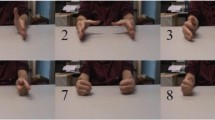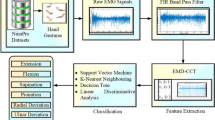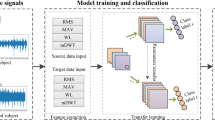Abstract
Bio-signal based hand motion recognition plays a critical role in the tasks of human-machine interaction, such as the natural control of multifunctional prostheses. Although a large number of classification technologies have been taken to improve the motion recognition accuracy, it is still a challenge to achieve acceptable performance for multiple modality input. This study proposes a multi-modality deep forest (MMDF) framework to identify hand motions, in which surface electromyographic signals (sEMG) and acceleration signals (ACC) are fused at the input level. The proposed MMDF framework constitutes of three main stages, sEMG and ACC feature extraction, feature dimension reduction, and a cascade structure deep forest for classification. A public database “Ninapro DB7” is used to evaluate the performance of the proposed framework, and the experimental results show that it can achieve a significantly higher accuracy than that of competitors. Besides, our experimental results also show that MMDF outperforms other traditional classifiers with the input of the single modality of sEMG signals. In sum, this study verifies that ACC signals can be an excellent supplementary for sEMG, and MMDF is a plausible solution to fuse mulit-modality bio-signals for human motion recognition.









Similar content being viewed by others
Explore related subjects
Discover the latest articles and news from researchers in related subjects, suggested using machine learning.References
Joshi D, Nakamura BH, Hahn ME (2015) High energy spectrogram with integrated prior knowledge for EMG-based locomotion classification. Med Eng Phys 37(5):518–524
Matrone GC, Cipriani C, Secco EL, Magenes G, Carrozza MC (2010) Principal components analysis based control of a multi-DoF underactuated prosthetic hand. J Neuroeng Rehabil 7(1):1–13
Kuzborskij I, Gijsberts A, Caputo B.(2012) On the challenge of classifying 52 hand movements from surface electromyography. In: 2012 Annual international conference of the IEEE engineering in medicine and biology society, IEEE, p 4931–4937
Liu J, Chen W, Li M, Kang X (2016) Continuous recognition of multifunctional finger and wrist movements in amputee subjects based on sEMG and accelerometry. Open Biomed Eng J 10:101
Chen H, Zhang Y, Li G, Fang Y, Liu H (2020) Surface electromyography feature extraction via convolutional neural network. Int J Mach Learn Cybern 11(1):185–196
Nogales RE, Benalcázar ME (2021) Hand gesture recognition using machine learning and infrared information: a systematic literature review. Int J Mach Learn Cybern 12(10):2859–2886
Atzori M, Gijsberts A, Castellini C, Caputo B, Hager A-GM, Elsig S, Giatsidis G, Bassetto F, Müller H (2014) Electromyography data for non-invasive naturally-controlled robotic hand prostheses. Sci Data 1(1):1–13
Atzori M, Gijsberts A, Kuzborskij I, Elsig S, Hager A-GM, Deriaz O, Castellini C, Müller H, Caputo B (2014) Characterization of a benchmark database for myoelectric movement classification. IEEE Trans Neural Syst Rehabil Eng 23(1):73–83
Gijsberts A, Atzori M, Castellini C, Müller H, Caputo B (2014) Movement error rate for evaluation of machine learning methods for sEMG-based hand movement classification. IEEE Trans Neural Syst Rehabil Eng 22(4):735–744
Zhou Z-H, Feng J (2019) deep forest: towards an alternative to deep neural networks. In: Proceedings of the twenty-sixth international joint conference on artificial intelligence (IJCAI-17), p 3553–3559
Jiang N, Muceli S, Graimann B, Farina D (2013) Effect of arm position on the prediction of kinematics from EMG in amputees. Med Biol Eng Cmput 51(1):143–151
Fougner A, Scheme E, Chan AD, Englehart K, Stavdahl Ø (2011) Resolving the limb position effect in myoelectric pattern recognition. IEEE Trans Neural Syst Rehabil Eng 19(6):644–651
Geng Y, Zhou P, Li G (2012) Toward attenuating the impact of arm positions on electromyography pattern-recognition based motion classification in transradial amputees. J Neuroeng Rehabil 9(1):1–11
Liu L, Chen X, Lu Z, Cao S, Wu D, Zhang X (2016) Development of an EMG-ACC-based upper limb rehabilitation training system. IEEE Trans Neural Syst Rehabil Eng 25(3):244–253
Zhang X, Chen X, Li Y, Lantz V, Wang K, Yang J (2011) A framework for hand gesture recognition based on accelerometer and EMG sensors. IEEE Trans Syst Man Cybern Part A Syst Hum 41(6):1064–1076
Khushaba RN, Al-Timemy A, Kodagoda S, Nazarpour K (2016) Combined influence of forearm orientation and muscular contraction on EMG pattern recognition. Expert Syst Appl 61:154–161
Young A, Kuiken T, Hargrove L (2014) Analysis of using EMG and mechanical sensors to enhance intent recognition in powered lower limb prostheses. J Neural Eng 11(5):056021
Atrey PK, Hossain MA, El Saddik A, Kankanhalli MS (2010) Multimodal fusion for multimedia analysis: a survey. Multimedia Syst 16(6):345–379
Xie X, Liu Z (2017) Dynamic gesture recognition method based on EMG and ACC signal. J Comput Appl 37:2700
Krasoulis A, Kyranou I, Erden MS, Nazarpour K, Vijayakumar S (2017) Improved prosthetic hand control with concurrent use of myoelectric and inertial measurements. J Neuroeng Rehabil 14(1):1–14
Guo Y, Liu S, Li Z, Shang X (2018) Bcdforest: a boosting cascade deep forest model towards the classification of cancer subtypes based on gene expression data. BMC Bioinform 19(5):1–13
Liu P, Wang X, Yin L, Liu B (2020) Flat random forest: a new ensemble learning method towards better training efficiency and adaptive model size to deep forest. Int J Mach Learn Cybern 11:2501–2513
Zhang Y, Xu T, Chen C, Wang G, Zhang Z, Xiao T (2021) A hierarchical method based on improved deep forest and case-based reasoning for railway turnout fault diagnosis. Eng Fail Anal 127:105446
Sun L, Mo Z, Yan F, Xia L, Shan F, Ding Z, Song B, Gao W, Shao W, Shi F (2020) Adaptive feature selection guided deep forest for COVID-19 classification with chest CT. IEEE J Biomed Health Inform 24(10):2798–2805
Daouadi KE, Rebaï RZ, Amous I (2021) Optimizing semantic deep forest for tweet topic classification. Inf Syst 101:10–18
Ding J, Wu Y, Luo Q, Du Y (2021) A fault diagnosis method of mechanical bearing based on the deep forest. J Vib Shock 40:107–113
Fang Y, Yang H, Zhang X, Liu H, Tao B (2020) Multi-feature input deep forest for EEG-based emotion recognition. Front Neurorobotics 14:617531
Englehart K, Hudgins B, Parker PA, Stevenson M (1999) Classification of the myoelectric signal using time-frequency based representations. Med Eng Phys 21(6–7):431–438
Oskoei MA, Hu H (2008) Support vector machine-based classification scheme for myoelectric control applied to upper limb. IEEE Trans Biomed Eng 55(8):1956–1965
Fougner A, Scheme E, Chan AD, Englehart K, Stavdahl Ø (2011) A multi-modal approach for hand motion classification using surface emg and accelerometers. In: 2011 Annual international conference of the IEEE engineering in medicine and biology society, IEEE, p 4247–4250
Phinyomark A, Phukpattaranont P, Limsakul C (2012) Feature reduction and selection for EMG signal classification. Expert Syst Appl 39(8):7420–7431
Fang Y, Yang J, Zhou D, Ju Z (2021) Modelling EMG driven wrist movements using a bio-inspired neural network. Neurocomputing 470:89–98
Cheng J, Chen M, Li C, Liu Y, Song R, Liu A, Chen X (2020) Emotion recognition from multi-channel EEG via deep forest. IEEE J Biomed Health Inf 25(2):453–464
Yao H, He H, Wang S, Xie Z 2019) EEG-based emotion recognition using multi-scale window deep forest. In: 2019 IEEE symposium series on computational intelligence (SSCI), IEEE, p 381–386 (
Sebelius FC, Rosen BN, Lundborg GN (2005) Refined myoelectric control in below-elbow amputees using artificial neural networks and a data glove. J Hand Surg 30(4):780–789
Liu FT, Ting KM, Yu Y, Zhou Z-H (2008) Spectrum of variable-random trees. J Artif Intell Res 32:355–384
Kong D, Zhu J (2019) Gesture recognition based on fusion of surface electromyography and acceleration information. Electron Meas Technol
Zhai Y, Lv P, Deng W, Xie X, Yu C, Gan J, Zeng J, Ying Z, Labati RD, Piuri V (2020) Facial beauty prediction via deep cascaded forest. Int J High Perform Syst Archit 9(2–3):97–106
Liu W, Fan H, Xia M (2021) Step-wise multi-grained augmented gradient boosting decision trees for credit scoring. Eng Appl Artif Intell 97:104036
Fang Y, Hettiarachchi N, Zhou D, Liu H (2015) Multi-modal sensing techniques for interfacing hand prostheses: a review. IEEE Sens J 15(11):6065–6076
Castellini C, Van Der Smagt P (2009) Surface EMG in advanced hand prosthetics. Biol Cybern 100(1):35–47
Acknowledgements
This work is supported in part by the basic public welfare research program of Zhejiang Province (No. LQ20F020016), the national natural science foundation of China (No. 62106147).
Author information
Authors and Affiliations
Corresponding author
Additional information
Publisher's Note
Springer Nature remains neutral with regard to jurisdictional claims in published maps and institutional affiliations.
Rights and permissions
Springer Nature or its licensor (e.g. a society or other partner) holds exclusive rights to this article under a publishing agreement with the author(s) or other rightsholder(s); author self-archiving of the accepted manuscript version of this article is solely governed by the terms of such publishing agreement and applicable law.
About this article
Cite this article
Fang, Y., Lu, H. & Liu, H. Multi-modality deep forest for hand motion recognition via fusing sEMG and acceleration signals. Int. J. Mach. Learn. & Cyber. 14, 1119–1131 (2023). https://doi.org/10.1007/s13042-022-01687-4
Received:
Accepted:
Published:
Issue Date:
DOI: https://doi.org/10.1007/s13042-022-01687-4




